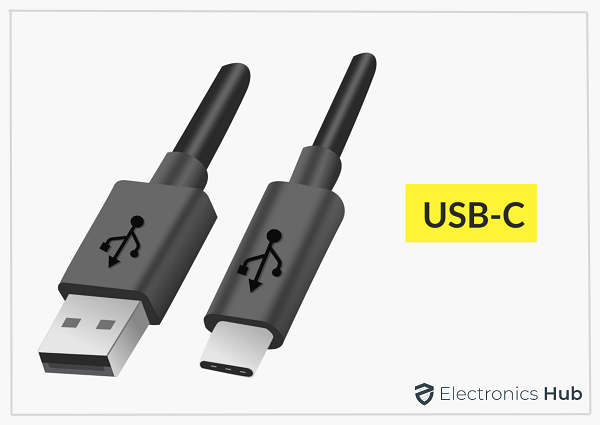Although, while all USB ports may function the same, they may have different connectors. You can find USB ports like USB type A, USB type B, and the newest one being USB type C. In fact, if you have bought any device recently, it most likely has a USB type C port. Today, we are here with a complete guide on what USB-C is, along with all the details regarding this port. You can go through this guide till the end to learn everything about USB type C.
What exactly is USB-C?
Just per the name, USB-C is a type of a highly popular USB port that offers both power and data over a single cable. And out of all the various USB port types out there, this is the most versatile and popular one since it is used by all kinds of devices. Talking about its physical connector, you get a reversible connector which is quite thin. Thanks to its physical connector, it can easily fit in thin laptops as well as mobile devices. Even though there are options like Lightning available in mobile devices, USB-C is universal and available for all devices instead of being limited to just Apple devices. Moving over to the performance of the USB type C port, it can support various versions of USB like USB 2.0, USB 3.0, USB 3.1, USB 3.2, USB 4, and even Thunderbolt depending on the device that you are using.
USB-C Advantages and Disadvantages
By now, you must have a decent idea about the USB-C port and how it is a great port for all kinds of computing devices. Although, just like anything else, even USB-C is not perfect, and it has its own advantages and disadvantages. And to get an idea of both sides of the picture, you should also check these USB-C advantages and disadvantages: Advantages:
Offers up to 40 Gbps speeds depending on port type Works as USB, video output, charging port, ethernet, PCI-E lanes Small and compact connector for thin and light computers Cross compatible among various platforms and devices Reversible connector for easy connection Wide range of available devices and accessories Uses a single cable to offer power and all its high-speed functions
Disadvantages:
You may need new cables and adapters for using USB C devices USB-C products are slightly more expensive than other USB types Not all USB type C ports perform the same
Speed, Power, and Video Delivery
Other than the advantages and disadvantages, you should also know about the performance numbers that USB-C offers to get an idea of the benefits that it offers over other USB ports. Starting with the transfer speed, USB-C can have its speeds ranging between 5 Gbps to 40 Gbps depending on the USB-C version you are using. This is due to the reason that USB-C has multiple versions which offer different speeds, as stated here: Apart from offering high transfer speeds, USB-C can also function as a video output port in most cases. Usually, this means that your computer’s USB-C port will offer the same performance as a DisplayPort 1.4 connector. Because of this, you can even drive up to an 8K 60 Hz display with ease. With Thunderbolt 3 connectors, you can even run dual 4K 60 Hz monitors off a single cable if you have the right connectors. Just like most other types of USB connectors out there, USB-C also supports power delivery. While by default, this is rated at 7.5 watts or 15 watts, most USB-C ports come with power delivery support. With power delivery, you can get a power output of up to 100 watts along with data transfer over a single cable. Some proprietary smartphone chargers can even offer 150 watts or higher power output over USB-C, making it highly versatile. This can be handy when you do not want to use your laptop’s charger and just want to run everything from a single cable.
Making USB-C Work
If you are coming from older connector types of USB, then it is essential to make sure that you get USB-C working for you. This simply means that all of your existing accessories and devices should be able to work along with it without facing any compatibility issues. Thankfully, making USB C work with your existing devices is quite easy. You can easily find adapters for USB C to USB A, USB A to USB C, and even Micro USB to USB C, which should be more than enough. There are also adapters for video output, SD card readers, ethernet, and more. With all these adapters and hubs, you can make USB-C highly functional.
USB-C Capabilities
As mentioned earlier, USB-C is a highly versatile port that offers much more functionality than your standard USB port. Even if your USB-C port does not support Thunderbolt, it will still work for data transfer, power delivery, ethernet, video output, audio output, and more. For these functionalities, you will need to either use the right accessories and devices or the right adapter made for that function. In case your USB-C port also supports Thunderbolt 3, then it means that it has PCI-E lanes shared with it. This makes USB-C useful for high-speed networking, external NVMe SSDs, and even for connecting eGPUs.
Conclusion
After checking all these details regarding USB-C, you must know about all its advantages and disadvantages. Since we have explained all its specifications and benefits, you must have a pretty good idea about this type of USB port. Because of its versatility, it is used in desktops, laptops, and even mobile devices. If you have gone through all the various details regarding USB-C present above, make sure to share your thoughts in the comments section. You can also post any questions down there if you have any! Comment * Name * Email * Website
Δ






![]()